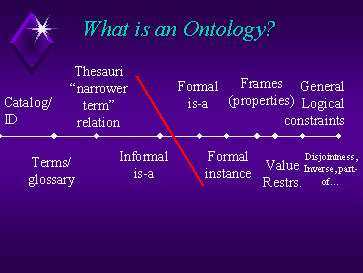Resource Description Framework (RDF)

- From two documents to a triple.
- Subject - Predicate - Object
- Add semantics to the link.
- Generalize the URI to identify anything.
- The object can be a string (with language or datatype).
Kjetil Kjernsmo <kjetil@kjernsmo.net>.
NUUG Meeting, 2011-01-11.
http://www.nuug.no/pub/dist/20110111-semantic-web/
The bane of my existence is doing things that I know the computer could do for me.
If the Web page with your personal calendar says you'll be in New York next Thursday, and the page with your workgroup calendar says you'll be in London all week, shouldn't the computer be able to warn you about the conflict? And shouldn't it go ahead and ask you if it's OK to cancel your flight to London and purchase this other ticket to New York?
Dan Connolly, 1998
1996 of the Web
| ★ | Available on the web (whatever format), but with an open licence |
| ★★ | Available as machine-readable structured data (e.g. excel instead of image scan of a table) |
| ★★★ | as (2) plus non-proprietary format (e.g. CSV instead of excel) |
| ★★★★ | All the above plus, Use open standards from W3C (RDF and SPARQL) to identify things, so that people can point at your stuff |
| ★★★★★ | All the above, plus: Link your data to other people's data to provide context |

<http://www.kjetil.kjernsmo.net/foaf#me> a foaf:Person ;
foaf:name "Kjetil Kjernsmo" ;
rel:parentOf <http://synne.kjernsmo.net/foaf#me> .
<http://synne.kjernsmo.net/foaf#me> a foaf:Person ;
foaf:givenName "Synne" ;
bio:event [ bio:date "2008-11-25"^^xsd:date ;
a bio:Birth ] .
Continuum of technologies for building ontologies.

Originally from AAAI 1999- Ontologies Panel by Gruninger, Lehmann, McGuinness, Uschold, Welty; – updated by McGuinness.
@base <http://synne.kjernsmo.net/world1> .
<> dc:title
"The world according to Synne, aged 1,
as recorded by her parents"@en ;
foaf:maker <http://synne.kjernsmo.net/foaf#me> .
<#vovv> a skos:Concept ;
skos:prefLabel "Vovv-vovv" ;
skos:narrower <#fur> .
<#fur> a skos:Concept ;
skos:prefLabel "Fur"@en ;
owl:sameAs <http://dbpedia.org/resource/Category:Fur> .
@base <http://synne.kjernsmo.net/world2> .
<> dc:title
"The world according to Synne, as recorded
by her parents, take two"@en ;
foaf:maker <http://synne.kjernsmo.net/foaf#me> .
<#gakk> a owl:Class
rdfs:label "Gakk-gakk" ;
owl:unionOf <#badeand>, <#real-duck> .
<#badeand> a owl:Class ;
rdfs:label "Badeand"@no .
<#real-duck> a owl:Class ;
rdfs:label "Ender, gjess, svaner"@no ;
rdfs:label "Duck, geese, swans"@en ;
owl:sameAs <http://dbpedia.org/resource/Anatidae>
<#vovv> a owl:Class ;
rdfs:label "Vovv-vovv" ;
owl:disjointWith <#gakk> .
<#tux> a <#vovv> ;
rdfs:label "Tux, the Linux penguin"@en ;
foaf:page <http://en.wikipedia.org/wiki/Tux> .
Don't let anyone force their ontology on you!
Economy makes it wise to adopt when you can
Unexpected reuse makes it wise to map when you can
A query language for the Semantic Web
Hides complexity
SELECT ?childname WHERE {
?parent a foaf:Person ;
rel:parentOf ?child .
?child foaf:givenName ?childname .
}
DESCRIBE ?child WHERE {
?parent a foaf:Person ;
rel:parentOf ?child .
}
PREFIX geo: <http://www.geonames.org/ontology#>
PREFIX foaf: <http://xmlns.com/foaf/0.1/>
PREFIX mo: <http://purl.org/ontology/mo/>
SELECT ?name ?homepage ?place ?population
WHERE
{ ?artisturi a mo:MusicArtist ;
foaf:based_near ?placeuri ;
foaf:name ?name .
OPTIONAL { ?artisturi foaf:homepage ?homepage . }
?placeuri
geo:name ?place ;
geo:inCountry <http://www.geonames.org/countries/#NO> .
OPTIONAL {?placeuri geo:population ?population . }
}
ORDER BY ?population
High object-relational impedance mismatch
Schema migration is usually painful
RDF and the Metaobject protocol is an interesting topic!
<div xmlns:dc="http://purl.org/dc/elements/1.1/"> <h2 property="dc:title">The trouble with Bob</h2> <h3 property="dc:creator">Alice</h3> ... </div>
<div typeof="product:Product gr:ProductOrServicesSomeInstancesPlaceholder" about="http://products.semweb.bestbuy.com/y/products/9509686/#ProductOrServicesSomeInstancesPlaceholder_9509686">
<span rel="rdfs:seeAlso" resource="http://www.bestbuy.com/site/olspage.jsp?skuId=9509686&type=product&id=1218116795548&cmp=RMX&ky=1whYTIhnZ0ydleik4tkW4Z7Fn1kPFrBgb"></span>
<div id="proddetails">
<h2 property="rdfs:label">Mac OS X v10.6 Snow Leopard: Mac</h2>
<div rel="gr:hasPriceSpecification" id="price">
<h3>Reg. Price:</h3>
<span typeof="gr:UnitPriceSpecification" about="http://products.semweb.bestbuy.com/y/products/9509686/#UnitPriceSpecification_9509686_1">
$<span property="gr:hasCurrencyValue" datatype="xsd:float">29.99</span>
<span property="gr:hasCurrency" datatype="xsd:string">USD</span>
<span property="gr:priceType" content="SRP" datatype="xsd:string"></span>
<span property="gr:hasUnitOfMeasurement" datatype="xsd:string" content="C62"></span>
<span property="gr:valueAddedTaxIncluded" datatype="xsd:boolean" content="true"></span>
</span>
</div>
Also WebID ("OpenID done right").